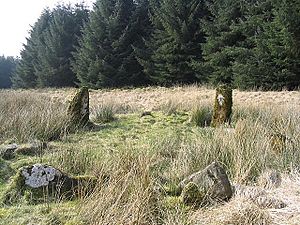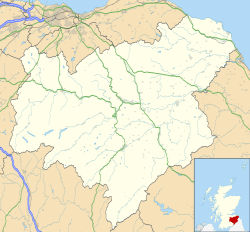Ninestane Rig facts for kids
 |
|
| Location | Between Newcastleton and Hawick, Liddesdale, Roxburghshire, Scottish Borders, Scotland |
|---|---|
| Coordinates | 55°16′02.93″N 2°45′39.12″W / 55.2674806°N 2.7608667°W |
| Type | Stone circle |
| History | |
| Periods | Early Bronze Age |
Ninestane Rig (which means Nine Stone Ridge in English) is a fascinating ancient stone circle in Scotland. It's located close to the border with England, in an area called Roxburghshire, not far from Hermitage Castle.
Experts believe this stone circle was built a very long time ago, between 2000 BC and 1250 BC. This period is known as the Late Neolithic or early Bronze Age. During the Bronze Age, people started using metal tools and weapons. Ninestane Rig is a special place because it's a scheduled monument. This means it's a nationally important archaeological site that is protected by law. It's part of a group of ancient sites nearby, including two other standing stones called Buck Stone and Greystone Hill.
Contents
What is Ninestane Rig?
The name "Ninestane Rig" actually refers to the low hill where the stone circle stands. This hill is about 287 meters (943 feet) high. However, the name is also commonly used to describe the stone circle itself. It's important not to confuse this site with other places that have similar names, like Nine Stones in Dorset or Nine Stones in Cornwall.
The Stone Circle Itself
The stone circle at Ninestane Rig isn't perfectly round; it's slightly oval. Originally, it had nine stones. Today, eight of these stones are still standing upright in the ground. The ninth stone has fallen over and lies flat.
Many of the stones are now just short stumps, about 0.6 meters (2 feet) tall or less. But there are two larger standing stones that are still impressive. One is a tall, regular stone, a bit less than 2.1 meters (7 feet) high. The other is a pointed stone, just over 1.2 meters (4 feet) tall.
Archaeologists believe that other similar stone circles used to exist in this area. Even though the stones from those circles have been removed, you can still see hollows in the ground where they once stood. Close to the circle, there's also a line of circular pits, about 2.4 to 3 meters (8 to 10 feet) deep. These pits might have been shelters for the people who built the stone circles, but we can't be completely sure.
The Legend of William de Soules
There's a famous old story connected to Ninestane Rig. The legend says that a powerful lord named William II de Soules, who lived at Hermitage Castle, was punished at this very spot in 1320. The story claims his tenants (the people who lived on his land) were so unhappy with him because he was cruel, that they boiled him alive in a large pot. They supposedly hung this pot from the two big stones at the circle.
William de Soules was also known for being a traitor. He was involved in a plot against Robert the Bruce, who was the King of Scotland. Some stories also say William was a sorcerer, meaning he practiced magic.
The Truth Behind the Legend
While the legend is a dramatic story, it's not actually true. Historians know that William II de Soules was not boiled alive. He was arrested for treason and died in prison at Dumbarton Castle, probably sometime before April 1321.
The pot mentioned in the legend was actually a relic from a different historical event, a rebellion in 1715. It's thought that the legend of William de Soules might have gotten mixed up with stories about an earlier ancestor of his, Ranulf II de Soules. Ranulf was killed by his servants around 1207 or 1208 because he was also considered very wicked. It's hard to know now if the two stories became one in the local oral traditions.


